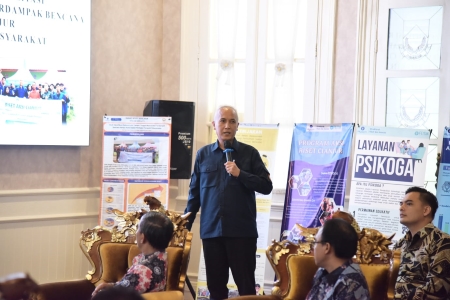ARIP House as an Earthquake Resistant Building Model as a Result of the Reconstruction Study of Community Residences Affected by the Cianjur Disaster

Head of the Center for Disaster Studies (PSB) IPB University, Dr Doni Yusri offers a model of building that is sturdy and earthquake resistant. The findings and recommendations of the earthquake-resistant house or building model are called 'Rumah ARIP' which is an acronym for Agronomy-Horticulture House of IPB.
"One building that still stands firmly in the IPB experimental land area, Pasir Sarongge, Cianjur Regency. The building seems very suitable for the conditions of earthquake-prone areas," he explained when delivering the final report related to the Cianjur Action Research Study on Thursday (30/3) at the Hall of Cianjur Regency.
In his report, Dr Doni explained that the Cianjur Action Research Study was a response to the Cianjur Earthquake Disaster on November 21, 2022. "The title of the Action Research conducted by PSB IPB University is the Identification Study of the Reconstruction of Community Residences Affected by the Cianjur Earthquake Disaster Based on Community Perspectives," he explained in front of the Regent of Cianjur, Rector of IPB University, and other invitees.
Dr Doni explained that the title of the action research was inspired by some input from disaster-affected residents after visiting several evacuation camps for earthquake victims during the emergency response phase. "Most of the people I met for discussion did not want to be moved," he said.
This phenomenon was then captured by Dr Doni to be used as an action research theme as stated in one of the research objectives of this study, which is to identify people's perspectives on their desire to restore socio-economic life in the reconstruction phase during recovery and rehabilitation phases.
"The research method uses a survey approach, interviews and descriptive data analysis and scoring. Respondents were randomly drawn as many as 150 people from five disaster-affected locations where their houses suffered damage ranging from light, medium to heavy damage categories," he added.
He revealed that the results of his research showed different perceptions between officials and affected communities. The majority of officials were of the view that the affected communities should be relocated to a new place. The reason is to avoid casualties and more severe damage to buildings, if the earthquake recurs in the future.
In contrast, the affected communities whose views were represented by respondents, almost 85 percent rejected relocation. "They prefer reconstruction of their homes in their old locations. "The reason for being close to the source of livelihood, life and life that is difficult to separate from themselves, and pessimism to get a better life in the future are among the reasons they do not want to be relocated," explained Dr Doni.
So far, the government through the Ministry of Public Works and Housing (PUPR) and also several universities have found and offered several models and options as earthquake-resistant houses or buildings.
"Any choice for the recovery of life and a better life for disaster-affected communities, the most important thing is the quality of houses or buildings that are sturdy and earthquake resistant," said Dr Doni at the end of his presentation. (*/Rz) (IAAS/NVA)


